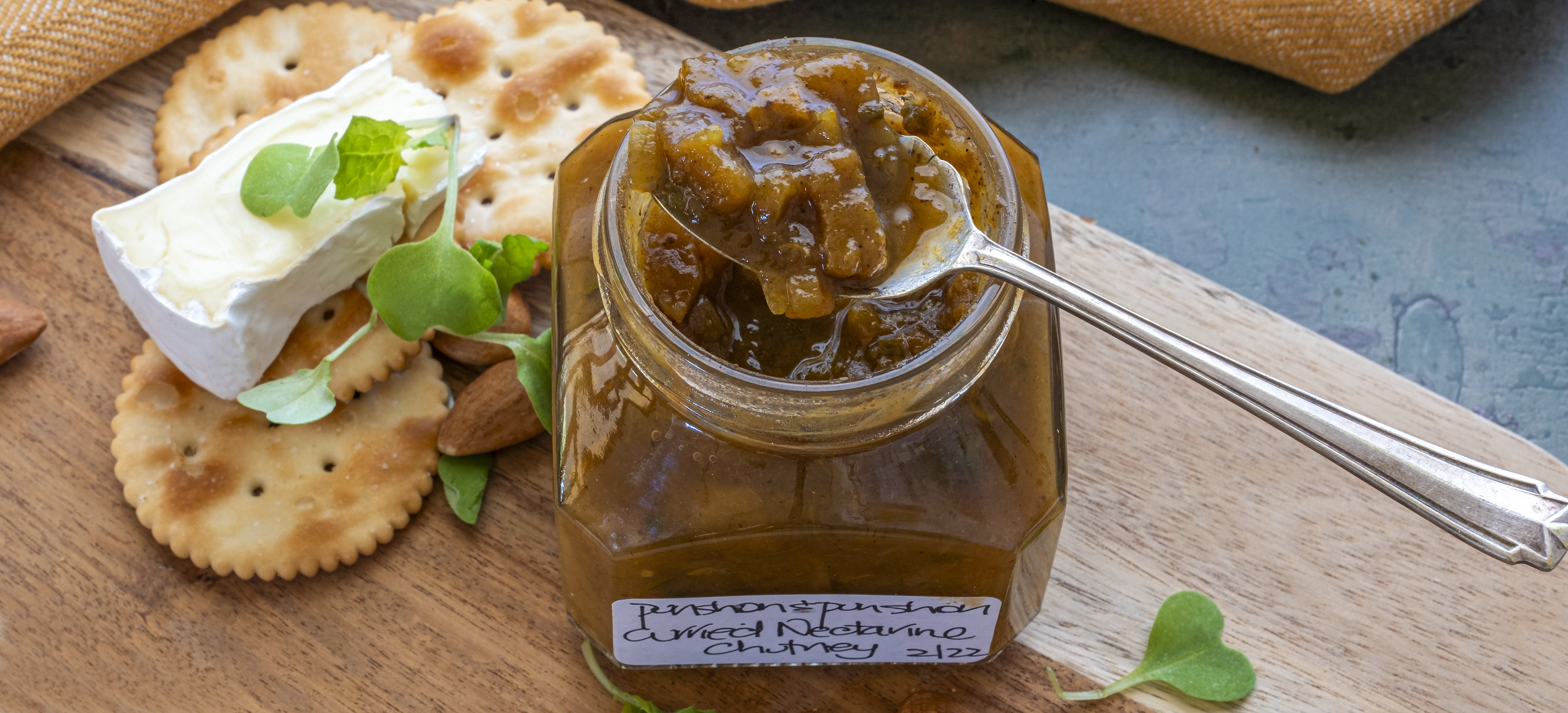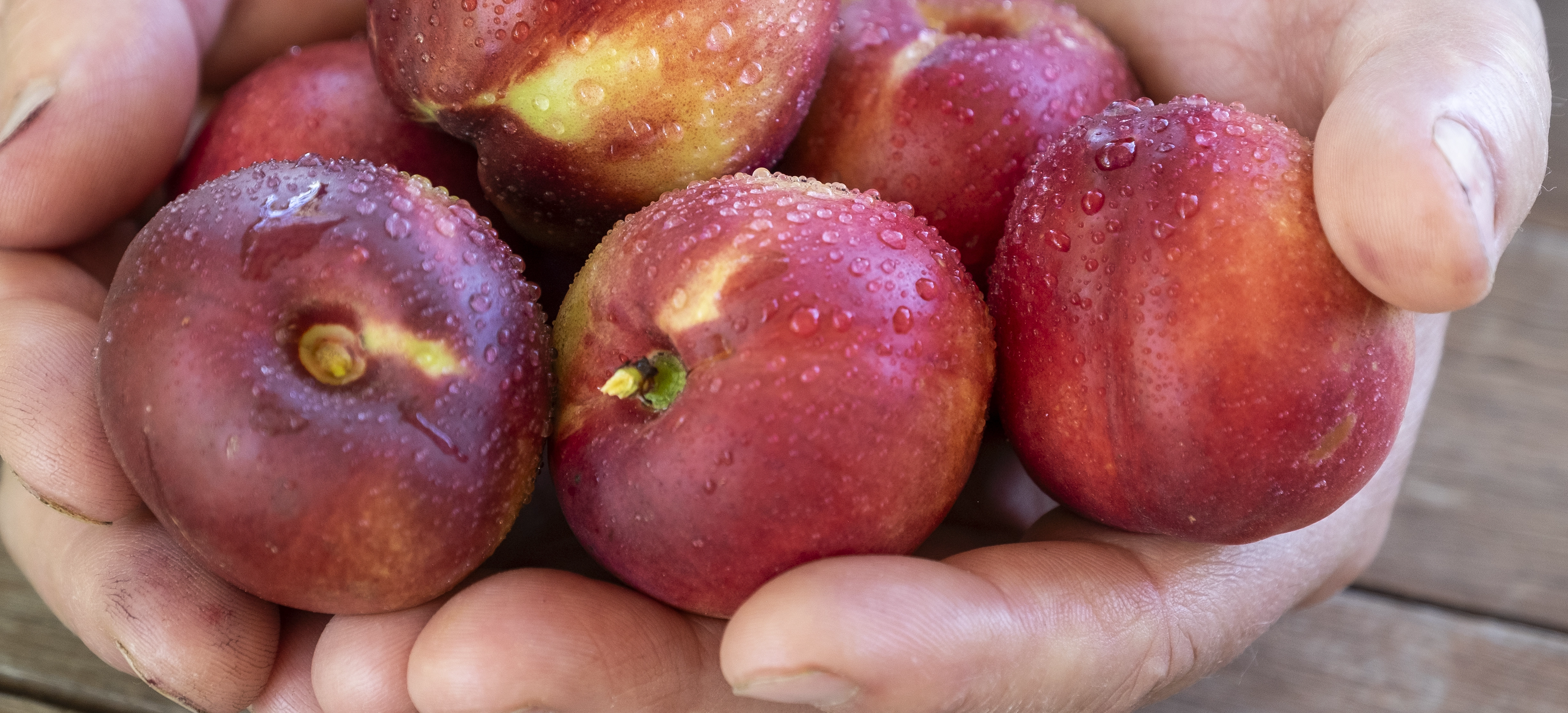Curried Nectarine Relish
- Pickles, Chutney, Relish & Sauces

Succulent fragrant nectarines combined with sweet and aromatic spices creates an exotic summery chutney that will be loved by all. It’s so versatile and apart from being enjoyed on the table as an accompaniment it also excels in being mixed into muffin batter or scone dough before being cooked, stirred into soft ricotta, cream or cottage cheese for a quick and very tasty dip or spread a spoonful or two into your next sandwich filling
- Preparation Time:
- 25 minutes
- Cooking Time:
- 45 minutes
- Quantity:
- 7 x250 ml jars
INGREDIENTS
- 1.5kg
- Yellow Nectarines, firm, ripe
- 215g
- White sugar
- 300ml
- Apple cider vinegar
- 215g
- Red onion, peeled, finely chopped
- 4
- Garlic cloves, peeled, finely chopped
- 20g
- Ginger, fresh, peeled, finely chopped
- 2
- Jalapeno chillies, finely chopped
- 3 teaspoons
- Curry powder
- 3 teaspoons
- Cumin powder
- 1/4 teaspoon
- Cinnamon powder
- 1/2 teaspoon
- Salt

METHOD
Wash and dry the nectarines and chillies to remove dirt or unwanted residues and garden debris. Dry gently on paper towel or a tea towel to remove excess moisture and remove any bruised or damaged fruit.
Cut nectarines in half, then remove and discard the stone. Cut into 2-3cm cubes.
Remove the skin and finely chop the red onion, garlic, and fresh ginger. Top and tail the jalapeno chilies. Remove the seeds and finely chop. For a hotter relish, the seeds should be used.
Place the chopped nectarine, onion, garlic, ginger, and chilies into a preserving or heavy bottom stainless steel pan. Add vinegar, sugar, spices, and salt.
Place on heat, bring to boil, then turn down to a simmer, stirring occasionally until all the sugar is dissolved. Allow to simmer gently, approximately 1 hour until the onion is soft and the chutney has reached a jammy consistency. Refer Notes Section: To Test Chutney Consistency.
Stir the mixture occasionally to ensure it does not stick to the bottom of the pan. If the fruit is not cooked enough and there’s insufficient liquid to continue cooking, add water as required.
Remove from the heat and place on a heat-resistant board to cool slightly.
Using a funnel, pour the hot chutney into hot dry sterilised jars and fill to approximately 2.5cm (1inch) from the top. Seal immediately with hot dry sterilised lids. Refer to the Notes Section: The HHH Sealing Method for more information.
Label and store in a cool dark place in the kitchen or pantry. Allow the chutney to mature for at least 2 weeks, preferably 4 weeks, before eating.
Once opened store in the refrigerator and use within 2 months.
NOTES
- Click here What's in a Name: Chutney or Relish . What you didn't know and have often wondered is now explained.
- Nectarines have a more delicate flavour than peaches, so to make an interesting preserve it needs to be teamed up with other ingredients that can provide a lift to the fruity nectarine base. They are a soft luscious fruit and will cook quickly. If you want a chunkier relish texture, cut the nectarine into larger pieces. I use the firmer yellow nectarine for preserving and savour white nectarines as a succulent, sweet and brightly acidic fresh summer fruit.

- Good quality jars should be used in preserving, particularly when they are processed in a hot water bath. Thin jars often cannot withstand the temperatures and may crack either in the bath or on and or after removal. Avoid the disappointment and invest in good jars from a homewares or preserves outlet. Select jars that have non-reactive lids as the vinegar solution can cause the lids to rust over time. It prevents, rust, moisture and other contaminants entry and spoiling your chutney.
- Choose clean ripe fruit. Do not use overripe and never use mouldy fruit as this will produce a poor-quality chutney.
- The type and colour of the sugar and vinegar used will affect the final colour and flavour of the chutney. Malt vinegar and brown sugar will produce very dark brownish chutney with a more earthy/molasses background flavour. White wine or apple cider vinegar and white sugar will allow the fresh fruit flavour of the nectarine to come through. I use white sugar with apple cider vinegar in this recipe to add more depth of flavour without overpowering nectarine’s unique flavour.
- The cooking time is an approximation only. Cooking time will depend upon, (1) the size of preserving pan- the broader the pan, the quicker the evaporation, (2) degree of fruit ripeness – the riper the fruit, the sweet and juicier the initial chutney will be and the (3) degree of heat when cooking – the higher the heat, the greater the boil which will produce greater evaporation.
- Towards the end of the cooking process, it may be necessary to stir regularly. It is important that the fruit does not stick to the bottom of the pan and burn. Your chutney will be tainted with a burnt flavour which is unpleasant.
- Chutney Consistency Test
- Spoon a little of the mixture on to a plate. It should hold its shape and have a jammy consistency.
- The HHH Sealing Method
- The HHH method of HOT dry jars, HOT dry lids and HOT chutney creates a vacuum seal as the chutney cools.
- The “popping” sound, often heard in the kitchen, signals a successfully vacuum sealed jar.
- Always store chutney/relish in a cool dark place. A warm area can cause it to ferment, and bright sunlight can affect the colour. Leave to mature for 2 months in a cool dark place before eating.
- Chilli
- It is important to wash your hands thoroughly after handling and de-seeding chillies. Chilli oil is easily transferred from the chillies to hands. If you touch your eyes or any delicate areas, the chilli oil will be transferred on contact and create a burning sensation.
- Why is chilli so hot? The legendary heat comes from a natural compound, capsaicin, which develops and is concentrated in the white pith with some migrating to the seeds. The amount of capsaicin a chilli contains depends upon the chilli variety and growing conditions. High temperatures and drought can increase capsaicin production as the chilli ripens. To control and reduce the amount of heat, use the most appropriate variety and amount of chilli, remove as much or little of the white membrane and seeds and vary the length of contact time with other ingredients while cooking to suit your taste.
- Chilli heat or pungency is measured in Scoville Heat Units (SHU) which was developed in 1912. The higher the Scoville rating the hotter the chilli. The ubiquitous Jalapeno varies between 2,500 – 10,000 SHU which is mild compared to the Habanero and Scotch Bonnets 80,000 – 150,000 SHU or the hottest chilli in the world, the Carolina Reaper, which has been measured at 2million SHU! Aptly named the Reaper; use with extreme caution.
- My article, Some like it Hot Hot Hot: The Scoville Factor takes a deeper dive into Wilbur Scoville's test and about our addiction to the ‘feel-good’ endorphins released when we eat chilli.
- Dried chilli develops a complex earthy, woody, and nutty flavor that is rare among other herbs and spices. Substitute dried chilli in recipes throughout the year, make your own special chilli powder blend with dried ground cumin, garlic and oregano or grind finely to make a hot chile powder.
 Cinnamon (Cinnamomum verum)
Cinnamon (Cinnamomum verum)- Cinnamon contains sweet and aromatic flavours. It does not taste sweet in itself, rather it enhances the perception of sweetness in other ingredients. It can draw out sweet notes in savoury dishes.
- Cinnamaldehyde is the main flavour compound and is sensed by the temperature sensors on the tongue, giving cinnamon a warming quality.
- Cinnamon sticks keep their flavours for up to a year. Keep in an airtight container and store in a cool dark place in the pantry or kitchen. The lighter brown, thinner more fragile sticks are higher quality.
- Inner layers of bark are dried in the sun and rolled together by hand to make “quills.”
- Cinnamon and cassis are distinctly different in appearance and flavours profile.
- Cumin (Cuminum cyminum)
- Seeds are harvested from annual plants and collected from the small, white, or pink-mauve flowers. The plants are cut down four months after planting then dried and threshed to separate the fruit, which is then dried further.
- The seeds are approximately 6mm long (1/4 inch) and will keep their flavour if stored in a sealed container in a cool, dark place.
- Cumin powder is also available, however, it loses its flavour and aroma quickly and should be used within a couple of months. It has an earthy, herby and woody flavour that is distinctive and highly aromatic and it has a pungent flavour.
- Thought to be native to the Nile Valley and Eastern Mediterranean, it's cultivated in India, China, Syria, Türkiye, and Iran.
- Curry powder
- Curry powder is a blend of sweet, pungent, hot and amalgamating spices. Using different combinations and proportions creates a variety of styles to suit different tastes. Amalgamating spices has the magical ability to harmonise the spice blend.
- The principal components of a Madras style curry powder include, cinnamon, allspice, nutmeg, cloves. cardamom, cumin, chili, pepper, fenugreek, fennel, coriander and turmeric.
- It’s believed the concept of a curry powder was initiated by the English colonists. On returning to England, they wanted to recreate the exotic flavours they enjoyed while serving in India.
- Curry powder should be stored in an airtight container away from extremes of heat, light and humidity. Under these conditions it should keep its flavour for 12 months.
- Ginger (Zingiber officinale)
- Ginger has a hot-spice, citrusy woody taste. It’s available as a fresh underground stem, a rhizome, as a finely ground powder and preserved in sugar.
- The dried and preserved version is used in baking, dried is also used in spice blends whereas fresh ginger is used widely in Asian cuisine.
- Do not substitute dried ginger for fresh, when specified in a recipe, as the dried form has a stronger and more aromatic flavour.
- When purchasing fresh ginger, avoid older rhizomes with signs of shrivelling as the plant is drying out and the flesh can be fibrous.

